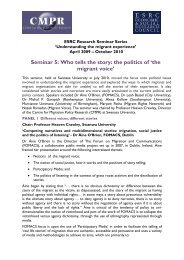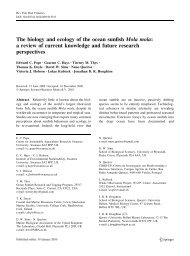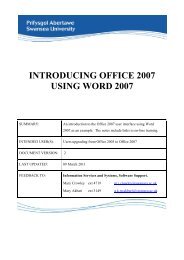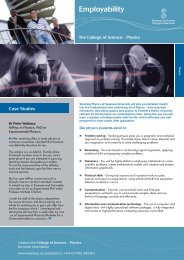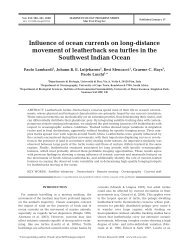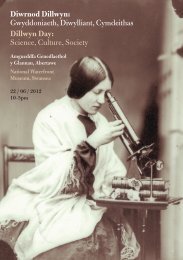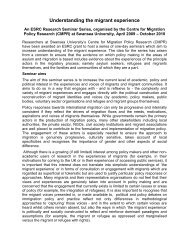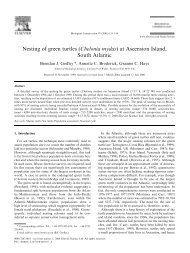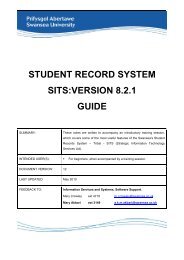The energy density of jellyfish - Swansea University
The energy density of jellyfish - Swansea University
The energy density of jellyfish - Swansea University
You also want an ePaper? Increase the reach of your titles
YUMPU automatically turns print PDFs into web optimized ePapers that Google loves.
Journal <strong>of</strong> Experimental Marine Biology and Ecology 343 (2007) 239–252<br />
www.elsevier.com/locate/jembe<br />
<strong>The</strong> <strong>energy</strong> <strong>density</strong> <strong>of</strong> <strong>jellyfish</strong>: Estimates from<br />
bomb-calorimetry and proximate-composition<br />
Thomas K. Doyle a,d, ⁎ , Jonathan D.R. Houghton b , Regina McDevitt c ,<br />
John Davenport d , Graeme C. Hays b<br />
a Environmental Research Institute, <strong>University</strong> College Cork, Lee Road, Cork, Ireland<br />
b Institute <strong>of</strong> Environmental Sustainability, Department <strong>of</strong> Biological Sciences,<br />
<strong>University</strong> <strong>of</strong> Wales <strong>Swansea</strong>, Singleton Park, <strong>Swansea</strong>, SA2 8PP, UK<br />
c Avian Science Research Centre, Animal Health Group, SAC Ayr, KA6 5HW, UK<br />
d Department <strong>of</strong> Zoology, Ecology and Plant Sciences, <strong>University</strong> College Cork, Distillery Fields, North Mall Cork, Ireland<br />
Received 20 October 2006; received in revised form 11 November 2006; accepted 11 December 2006<br />
Abstract<br />
Two techniques are described to calculate <strong>energy</strong> densities for the bell, gonad and oral arm tissues <strong>of</strong> three scyphozoan <strong>jellyfish</strong><br />
(Cyanea capillata, Rhizostoma octopus and Chrysaora hysoscella). First, bomb-calorimetry was used, a technique that is readily<br />
available and inexpensive. However, the reliability <strong>of</strong> this technique for gelatinous material is contentious. Second, further analysis<br />
involving the more labour intensive proximate-composition analysis (protein, fat and carbohydrate) was carried out on two species<br />
(C. capillata and R. octopus). <strong>The</strong>se proximate data were subsequently converted to <strong>energy</strong> densities. <strong>The</strong> two techniques (bombcalorimetry<br />
and proximate-composition) gave very similar estimates <strong>of</strong> <strong>energy</strong> <strong>density</strong>. Differences in <strong>energy</strong> <strong>density</strong> were found<br />
both amongst different species and between different tissues <strong>of</strong> the same species. Mean (±S.D.) <strong>energy</strong> <strong>density</strong> estimates for whole<br />
animals from bomb-calorimetry were 0.18±0.05, 0.11±0.04, and 0.10±0.03 kJ g wet mass − 1 for C. capillata, R. octopus, and<br />
C. hysoscella respectively. <strong>The</strong> implications <strong>of</strong> these low <strong>energy</strong> densities for species feeding on <strong>jellyfish</strong> are discussed.<br />
© 2007 Elsevier B.V. All rights reserved.<br />
Keywords: Bioenergetic models; Chrysaora; Cyanea; Foraging ecology; Leatherback turtle; Marine food webs; Rhizostoma<br />
1. Introduction<br />
Food quality has fundamental implications for the<br />
ecology <strong>of</strong> all species. For example, vertebrates that feed<br />
on nutritionally high quality food (e.g. carnivores)<br />
typically spend a large proportion <strong>of</strong> their time resting or<br />
socialising in-between foraging bouts. Conversely,<br />
animals that feed on nutritionally lower quality foods<br />
⁎ Corresponding author. Environmental Research Institute, <strong>University</strong><br />
College Cork, Lee Road, Cork, Ireland.<br />
E-mail address: t.doyle@ucc.ie (T.K. Doyle).<br />
(e.g. herbivores) <strong>of</strong>ten need to allocate more time to<br />
foraging (Fortin et al., 2002; Shrader et al., 2006).<br />
However, for some predators, information on the<br />
nutritional quality <strong>of</strong> their prey is lacking or poorly<br />
documented. This is clearly illustrated by ‘scyphozoan<br />
medusae’ <strong>of</strong> the Phylum Cnidaria (from hereon referred<br />
to as ‘<strong>jellyfish</strong>’) which were once considered unimportant<br />
and energetic dead ends in pelagic food webs but<br />
are now considered intrinsic dietary components for an<br />
increasing range <strong>of</strong> vertebrate and invertebrate species<br />
(Arai, 2005; Houghton et al., 2006a,b). For example,<br />
leatherback sea turtles (Dermochelys coriacea Vandelli)<br />
0022-0981/$ - see front matter © 2007 Elsevier B.V. All rights reserved.<br />
doi:10.1016/j.jembe.2006.12.010
240 T.K. Doyle et al. / Journal <strong>of</strong> Experimental Marine Biology and Ecology 343 (2007) 239–252<br />
are regularly seen in areas where <strong>jellyfish</strong> are abundant<br />
at the surface, and have been observed to consume up to<br />
200 kg <strong>of</strong> <strong>jellyfish</strong> a day (Duron, 1978; James and<br />
Herman, 2001; Houghton et al., 2006b). Other examples<br />
<strong>of</strong> predators now known to prey on <strong>jellyfish</strong> include<br />
many arthropods, fish and birds (Arai, 2005); however,<br />
their importance as prey items does not end in the<br />
pelagic realm. Recent research has shown that large<br />
aggregations <strong>of</strong> moribund <strong>jellyfish</strong> may be important<br />
vectors for carbon transport to the deep sea in many<br />
areas <strong>of</strong> the world ocean with <strong>jellyfish</strong> detritus possibly<br />
acting as a good food source for benthic fauna (Billett<br />
et al., 2006). Furthermore, considering that <strong>jellyfish</strong> may<br />
become more important in some marine systems as a<br />
result <strong>of</strong> climate change and/or overfishing (Mills, 2001;<br />
Lynam et al., 2006), their overall ecosystem impact as<br />
prey (and predators) may similarly increase. Unfortunately,<br />
as the <strong>energy</strong> <strong>density</strong> <strong>of</strong> <strong>jellyfish</strong> is relatively<br />
poorly documented when compared to other pelagic<br />
taxa (Arai, 1997), constructing bioenergetic models for<br />
species that prey on <strong>jellyfish</strong> (Davenport, 1998; Lynam<br />
et al., 2006; Wallace et al., 2006), and trophic dynamic<br />
models that incorporate <strong>jellyfish</strong>, may be problematic.<br />
<strong>The</strong> lack <strong>of</strong> information on the <strong>energy</strong> <strong>density</strong> <strong>of</strong><br />
<strong>jellyfish</strong> is partly caused by methodological problems<br />
associated with the high salt content, high water content<br />
(95–98% wet mass) and extremely low <strong>energy</strong> <strong>density</strong><br />
<strong>of</strong> this group (Larson, 1986; Lutcavage and Lutz, 1986;<br />
Clarke et al., 1992; Lucas, 1994; Arai, 1997). More<br />
specifically, in proximate composition analysis, the sum<br />
<strong>of</strong> protein, lipid and carbohydrate fractions (g) are<br />
termed ‘total organics’ and taken to be synonymous with<br />
ash free dry mass (AFDM) or the mass combusted when<br />
samples are ashed in a furnace (Lucas, 1994). However,<br />
for gelatinous zooplankton there is a discrepancy or an<br />
unaccounted difference between ‘total organics’ and<br />
‘AFDM’. This difference is thought to be residual/<br />
bound water that remains in the dried <strong>jellyfish</strong>, even<br />
after drying to constant mass. <strong>The</strong> amount <strong>of</strong> ‘water <strong>of</strong><br />
hydration’ remaining after drying, was estimated to be<br />
∼11.7% by Madin et al. (1981) for salps and Larson<br />
(1986) for Aurelia aurita L. and Cyanea capillata L.<br />
This bound water, combined with a low <strong>energy</strong> <strong>density</strong><br />
may render traditional methods for estimating <strong>energy</strong><br />
<strong>density</strong>, such as bomb-calorimetry, unreliable (Lutcavage<br />
and Lutz, 1986).<br />
To tackle these uncertainties and provide baseline<br />
data for future bioenergetic studies, we compared two<br />
techniques for measuring the <strong>energy</strong> <strong>density</strong> <strong>of</strong> <strong>jellyfish</strong>:<br />
bomb-calorimetry and proximate-composition. Bombcalorimetry<br />
is relatively quick, inexpensive and thus<br />
appropriate for large sample sizes if the analytical<br />
uncertainties <strong>of</strong> this approach when applied to <strong>jellyfish</strong><br />
can be resolved. Bomb-calorimetry measures the heat<br />
liberated when ‘food/or a sample’ is combusted in a<br />
sealed chamber (the bomb) surrounded by water. <strong>The</strong><br />
heat liberated (heat <strong>of</strong> combustion) represents the food's<br />
total <strong>energy</strong> or gross <strong>energy</strong> value (GE). <strong>The</strong> second<br />
approach, proximate-composition analysis, provides<br />
more reliable estimates <strong>of</strong> <strong>energy</strong> <strong>density</strong> but is time<br />
consuming (Arai, 1997), expensive and requires much<br />
more sample material. Proximate composition measures<br />
the protein, carbohydrate and lipid content <strong>of</strong> a sample.<br />
<strong>The</strong> measured fractions are then multiplied by the<br />
combustion equivalents <strong>of</strong> these compounds. Importantly,<br />
it provides a good benchmark for assessing the<br />
reliability <strong>of</strong> bomb-calorimetry. Our aim, therefore, was<br />
to compare results derived from the same material, using<br />
both methods. We applied the techniques to three<br />
species <strong>of</strong> <strong>jellyfish</strong>, C. capillata, Rhizostoma octopus<br />
L., and Chrysaora hysoscella L., all <strong>of</strong> which are <strong>of</strong>ten<br />
abundant at high latitudes (Doyle et al., in press) and<br />
hence may play important ecosystem roles.<br />
2. Materials and methods<br />
2.1. Collection and drying process<br />
Fresh specimens <strong>of</strong> C. hysoscella (n =10) were<br />
collected from the side <strong>of</strong> a jetty in Dingle Harbour,<br />
County Kerry, Ireland (52.13°N, 10.36°W), using a dip<br />
net. Freshly stranded specimens <strong>of</strong> C. capillata (n=27)<br />
were collected from Laytown Beach, County Meath,<br />
Ireland (53.67°N, 6.23°W). <strong>The</strong>se specimens were<br />
either freshly stranded on the beach or were in the<br />
process <strong>of</strong> stranding (i.e. still in the water) when<br />
collected. Samples that were directly removed from the<br />
beach were gently dipped in a bucket <strong>of</strong> seawater to<br />
remove any sand. Fresh specimens <strong>of</strong> R. octopus<br />
(n=10) were collected from Rosslare Harbour, County<br />
Wexford, Ireland (52.37°N, 6.36°W), using a dip net. In<br />
all the above sampling events, the wet mass <strong>of</strong><br />
individual specimens was measured to the nearest<br />
gram, and the bell (umbrella) diameter measured to<br />
the nearest centimetre. Each <strong>jellyfish</strong> was then dissected<br />
into three distinct body components (or tissues): bell,<br />
oral arms and gonads. <strong>The</strong>se tissues were individually<br />
stored in plastic bags, weighed, and within 1–2 h were<br />
frozen at −20 °C. All <strong>jellyfish</strong> were collected during<br />
July–October 2004.<br />
During November 2004, samples were removed from<br />
the freezer and allowed to thaw. Samples were<br />
homogenized into a ‘jelly soup’ using a blender, and<br />
poured into pre-weighed aluminium cartons. Individual
T.K. Doyle et al. / Journal <strong>of</strong> Experimental Marine Biology and Ecology 343 (2007) 239–252<br />
241<br />
samples (component plus aluminium carton) were<br />
weighed and then placed in an oven at a constant<br />
temperature <strong>of</strong> 65 °C and dried to constant mass. During<br />
the drying process, samples were removed and weighed<br />
once or twice a day. Prior to weighing, samples were<br />
first allowed to cool to room temperature in a desiccator,<br />
and immediately after weighing returned to the oven if a<br />
constant mass had not been achieved. On occasions it<br />
was necessary to ‘scrape and stir’ the sample to remove<br />
or prevent a surface layer (skin) forming that slowed the<br />
drying process. As large granules sometimes formed<br />
during this process, it was necessary to use a mortar and<br />
pestle to grind these samples into a fine powder. <strong>The</strong>se<br />
ground samples were then returned to the oven for<br />
additional drying.<br />
2.2. Determination <strong>of</strong> gross <strong>energy</strong> (GE) using<br />
bomb-calorimetry<br />
<strong>The</strong> gross <strong>energy</strong> (GE) was determined for individual<br />
tissue samples <strong>of</strong> C. capillata (n=25), R. octopus<br />
(n=17), and C. hysoscella (n =29) using a Gallenkamp<br />
Autobomb adiabatic calorimeter. <strong>The</strong> calorimeter had<br />
two stainless steel bombs and two calorimeter chambers,<br />
A and B. Each bomb was always used with the same<br />
calorimeter chamber during GE determinations. <strong>The</strong><br />
heat capacity (hc) <strong>of</strong> each separate pair <strong>of</strong> bomb and<br />
calorimeter chamber, plus the mass <strong>of</strong> water within the<br />
calorimeter chamber, was determined as follows: hc=<br />
[(GE ×wt)+0.167] /ΔT. Where, hc=heat capacity <strong>of</strong><br />
bomb (kJ °C − 1 ), GE=gross <strong>energy</strong> <strong>of</strong> benzoic acid<br />
(26.46 kJ g − 1 ), wt=weight <strong>of</strong> pellet in grams and<br />
ΔT=final temperature−initial temperature (in °C). <strong>The</strong><br />
heat capacity for each bomb chamber was 10.822 kJ °C.<br />
As is standard practice in adiabatic bomb calorimetry<br />
methodology, the same mass <strong>of</strong> water (±0.5 g) was<br />
always used for each bomb and calorimeter chamber<br />
pairing between GE determinations in order to maintain<br />
a constant heat capacity.<br />
Each chamber was also calibrated for the heat <strong>of</strong><br />
combustion <strong>of</strong> 1 g <strong>of</strong> benzoic acid (26.46 kJ g − 1 )ona<br />
daily basis. Typically, 0.70 g <strong>of</strong> sample material (e.g.<br />
food or animal tissue) would be combusted for<br />
determination <strong>of</strong> GE in this system. However, to ensure<br />
combustion <strong>of</strong> the ground <strong>jellyfish</strong> samples, 0.50 g <strong>of</strong><br />
sample was mixed with 0.50 g <strong>of</strong> benzoic acid in a<br />
weighing boat to give a composite sample, and<br />
manually pelleted using a hydraulic pelleting press<br />
(Enerpac). Once pelleted, samples were kept in a<br />
silica gel dessicator. <strong>The</strong> change in temperature to a<br />
constant temperature due to combustion <strong>of</strong> the sample<br />
(approximately 10 min post-ignition) was detected using<br />
a Beckmann thermometer, accurate to 0.001 °C. <strong>The</strong> GE<br />
<strong>of</strong> each composite sample was determined using<br />
standard procedures (McLean and Tobin, 1987) and<br />
calculated as; GE=[(TrK×K10.822/sample weight) K<br />
kJ g − 1 ]. Where Tr is the change in temperature <strong>of</strong> the<br />
calorimeter between initial and post-combustion <strong>of</strong> the<br />
sample, and 10.882 (kJ °C − 1 ) is the heat capacity<br />
constant for the chambers. <strong>The</strong> GE value was corrected<br />
for the contribution that 0.50 g <strong>of</strong> benzoic acid made to<br />
the combustion <strong>of</strong> the composite sample, to give the<br />
equivalent <strong>of</strong> a 1 g <strong>jellyfish</strong> sample. As is standard<br />
practice, the GE values were not corrected for the<br />
potential small effect <strong>of</strong> nitric or sulphuric acid formed<br />
during the combustion process (McLean and Tobin,<br />
1987).<br />
2.3. Proximate-composition analysis<br />
2.3.1. Ash determination<br />
<strong>The</strong> inorganic matter or ash content <strong>of</strong> samples was<br />
determined for individual tissues samples <strong>of</strong> C. capillata<br />
(n=39) and R. octopus (n=8) using the AOAC 16.267<br />
method (AOAC, 1990). Insufficient sample material <strong>of</strong><br />
C. hysoscella prevented similar ash/proximate composition<br />
analysis for this species. A known mass <strong>of</strong> sample<br />
(∼1 g±0.1 mg) that had been dried to constant mass,<br />
was ashed in a furnace at 600 °C for 6 h. <strong>The</strong> ash content<br />
was calculated by the difference between initial and<br />
final mass <strong>of</strong> the sample. Analysis was carried out in<br />
triplicate per sample.<br />
2.3.2. Protein, lipid and carbohydrate determination<br />
for individual tissue samples<br />
<strong>The</strong> protein content was determined for individual<br />
tissue samples <strong>of</strong> C. capillata (n=47) and R. octopus<br />
(n=8) using the macro-Kjeldahl method (Association <strong>of</strong><br />
Official Analytical Chemists (AOAC, 1990) method,<br />
International Dairy Federation (IDF) Standard 20B:<br />
1993). For calculation <strong>of</strong> the % protein in a sample, the<br />
% N was multiplied by a conversion factor <strong>of</strong> 5.8<br />
(Gnaiger and Bitterlich, 1984; Clarke et al., 1992). All<br />
protein analysis was carried out in triplicate.<br />
<strong>The</strong> fat content <strong>of</strong> individual tissues was determined<br />
for C. capillata (n=9) and R. octopus (n=7) using a<br />
Soxtec 2055 Avanti instrument (Foss, Ireland). All fat<br />
analyses were carried out in duplicate.<br />
<strong>The</strong> carbohydrate content <strong>of</strong> the samples was<br />
determined colorimetrically by measuring glycogen<br />
content (Cary Varian UV–Visible spectrophotometer)<br />
after acid digestion <strong>of</strong> individual tissue samples <strong>of</strong><br />
C. capillata (n=9) and R. octopus (n=7). All carbohydrate<br />
analysis was carried out in duplicate.
242 T.K. Doyle et al. / Journal <strong>of</strong> Experimental Marine Biology and Ecology 343 (2007) 239–252<br />
2.3.3. Data analysis<br />
To calculate the <strong>energy</strong> content <strong>of</strong> C. capillata and<br />
R. octopus from proximate-composition, the measured<br />
quantities (in grams) <strong>of</strong> the various fractions (protein, lipid<br />
and carbohydrate), were multiplied by the known mean<br />
combustion equivalents <strong>of</strong> these compounds (i.e.<br />
Table 1<br />
Wet and dry mass (g) for individual tissues <strong>of</strong> C. hysoscella, C. capillata and R. octopus with associated bell diameters<br />
Species<br />
ID<br />
#<br />
Bell<br />
diameter<br />
(cm)<br />
Wet mass (g)<br />
Dry mass (g)<br />
G OA B W G OA B W<br />
C. hysoscella 1 17 78 47 277 402 4.1 1.8 10.2 16.0<br />
C. hysoscella 2 24 184 187 500 871 8.9 7.0 18.4 34.4<br />
C. hysoscella 3 18 48 36 188 272 2.4 1.6 7.0 10.9<br />
C. hysoscella 4 21 109 123 383 615 5.0 4.7 14.0 23.7<br />
C. hysoscella 5 22 133 212 417 762 6.2 8.1 16.0 30.2<br />
C. hysoscella 6 24 266 135 480 881 11.7 5.2 17.7 34.5<br />
C. hysoscella 7 24 130 143 487 761 6.1 5.3 18.4 29.9<br />
C. hysoscella 8 17 96 19 152 266 4.2 0.8 5.7 6.6<br />
C. hysoscella 9 17 89 36 299 423 4.2 1.6 10.9 16.6<br />
C. hysoscella 10 19 61 49 231 341 3.3 2.1 8.5 13.9<br />
Mean (±S.D.) 20.1 (3.0) 119 (65) 99 (70) 341 (129) 559 (246) 5.6 (2.8) 3.8 (2.6) 12.7 (4.8) 21.7 (10.2)<br />
C. capillata 1 47 135 546 1008 1689 7.8 26.3 42.6 76.8<br />
C. capillata 2 40 176 832 1562 2570 11.0 41.9 66.4 119.3<br />
C. capillata 3 33 61 553 1154 1768 3.1 27.0 46.8 76.9<br />
C. capillata 4 28 32 365 693 1089 1.4 17.4 28.0 46.8<br />
C. capillata 5 35 101 574 1337 2011 5.1 28.1 52.4 85.6<br />
C. capillata 6 37 67 623 1418 2108 3.5 31.5 58.6 93.6<br />
C. capillata 7 28 13 21 211 244 0.6 1.4 9.0 11.0<br />
C. capillata 8 31 42 295 902 1239 2.5 14.2 29.7 46.4<br />
C. capillata 9 33 70 129 1157 1356 4.2 7.2 47.0 58.4<br />
C. capillata 10 29 112 262 803 1177 7.0 12.8 32.8 52.5<br />
C. capillata 11 33 118 301 1272 1692 9.4 17.8 47.4 74.5<br />
C. capillata 12 26 20 55 475 551 1.2 4.3 19.1 24.5<br />
C. capillata 13 36 108 107 1329 1544 5.3 6.3 49.5 61.1<br />
C. capillata 14 36 420 868 1234 2521 24.2 36.1 46.9 107.2<br />
C. capillata 15 27 42 74 620 736 1.9 3.7 22.4 28.0<br />
C. capillata 16 27 20 154 524 698 1.0 7.1 19.8 27.8<br />
C. capillata 17 36 198 621 1018 1838 9.9 25.8 37.3 73.0<br />
C. capillata 18 29 76 369 552 997 3.7 16.2 20.4 40.2<br />
C. capillata 19 24 34 73 349 456 1.6 3.9 12.7 18.2<br />
C. capillata 20 37 69 461 1453 1984 3.2 20.5 55.6 79.3<br />
C. capillata 21 30 125 724 617 1466 6.3 30.4 23.3 60.0<br />
C. capillata 22 28 147 75 970 1192 6.8 4.7 36.5 48.0<br />
C. capillata 23 20 50 141 293 484 2.9 6.8 11.3 21.0<br />
C. capillata 24 23 48 388 448 885 2.4 17.4 16.7 36.5<br />
C. capillata 25 27 20 132 754 906 1.1 6.6 29.5 37.2<br />
C. capillata 26 15 12 5 171 188 0.7 0.3 6.8 7.8<br />
C. capillata 27 24 51 228 437 716 2.6 10.3 17.5 30.4<br />
Mean (±S.D.) 30.3 (6.6) 88 (83) 332 (258) 843 (415) 1263 (662) 4.8 (4.9) 15.8 (11.6) 32.8 (16.7) 53.4 (29.3)<br />
R. octopus 1 36 213 1372 822 2407 9.0 57.0 29.9 95.9<br />
R. octopus 2 57 1522 3920 3412 8854 64.9 176.0 80.8 321.6<br />
R. octopus 3 48 72 2871 4319 7262 5.6 115.5 156.5 277.6<br />
R. octopus 4 51 581 3093 4068 7742 26.1 122.0 172.7 320.8<br />
R. octopus 5 23 12 413 177 602 0.5 16.8 6.4 23.8<br />
R. octopus 6 23 21 328 570 919 0.5 15.4 11.4 27.3<br />
R. octopus 7 18 15 70 241 326 0.7 2.9 10.0 13.6<br />
R. octopus 8 15 9 67 183 259 0.5 2.4 6.3 9.3<br />
R. octopus 9 13 14 24 31 69 0.2 1.3 1.2 2.7<br />
R. octopus 10 11 – 20 52 72 – 1.2 2.3 3.4<br />
Mean (±S.D.) 29.5 (17.1) 246 (483) 1218 (1510) 1388 (1787) 2851 (3605) 10.8 (20.6) 51.0 (64.1) 47.8 (66.0) 109.6 (139.1)<br />
G=gonads, OA=oral arms, and B=bell. Values for whole <strong>jellyfish</strong> (W) are derived from the sum <strong>of</strong> the three tissues (gonads, oral arms and bell).
T.K. Doyle et al. / Journal <strong>of</strong> Experimental Marine Biology and Ecology 343 (2007) 239–252<br />
243<br />
23.9 kJ g −1 for protein, 39.5 kJ g −1 for lipid and<br />
17.5 kJ g −1 for carbohydrate; see Clarke et al., 1992). All<br />
the proximate-composition data (including ash content)<br />
and subsequent <strong>energy</strong> <strong>density</strong> estimates were corrected<br />
for the effect <strong>of</strong> bound water by assuming a ‘water <strong>of</strong><br />
hydration’ <strong>of</strong> 11.7% DM (Larson, 1986; Lucas, 1994).<br />
<strong>The</strong> following equations can be used to determine revised<br />
<strong>energy</strong> densities kJ g DM −1 , assuming 11.7% water <strong>of</strong><br />
hydration. Revised GE kJ g −1 =[(proportion <strong>of</strong> protein×a)+(proportion<br />
<strong>of</strong> lipid×b)+(proportion <strong>of</strong> carbohydrate×c)]×d.<br />
Where:a=23.9 (gross <strong>energy</strong> value for<br />
protein in kJ g −1 ); b=39.5 (gross <strong>energy</strong> value for lipid in<br />
kJ g −1 ); c=17.5 (gross <strong>energy</strong> value for carbohydrate in<br />
kJ g −1 ); d=water <strong>of</strong> hydration correction factor <strong>of</strong> 1.13<br />
(i.e. water <strong>of</strong> hydration=11.7% or 0.117; therefore 1–<br />
0.117=0.883; 1/0.883=1.13). For example: if a dried<br />
<strong>jellyfish</strong> gonad sample was 27.3% DM protein, 0.58% DM<br />
lipid, and 0.94% DM carbohydrate, then the <strong>energy</strong> <strong>density</strong><br />
would be 1/0.883 [(0.273×23.9)+ (0.0058× 39.5)+<br />
(0.0094×17.5)]=7.83 kJ g DM −1 . Similarly, to correct<br />
for the dilution effect <strong>of</strong> the bound water <strong>of</strong> hydration, the<br />
<strong>energy</strong> <strong>density</strong> values from bomb-calorimetry were<br />
multiplied by 1.13.<br />
All percentage data were arcsine square root<br />
transformed prior to statistical analysis, and untransformed<br />
back to get means and S.D. in percentages.<br />
To test the difference between two slopes we used the<br />
test statistic t=(b1−b2)/(SE1 2 +SE2 2 ) 1/2 , described by<br />
Fowler et al. (1998), where b1=slope 1; b2=slope 2,<br />
SE1 =Standard error coefficient <strong>of</strong> slope 1; SE2=Standard<br />
error coefficient <strong>of</strong> slope 2.<br />
3. Results<br />
3.1. Raw results before correcting for bound water <strong>of</strong><br />
hydration<br />
3.1.1. Wet mass, DM and water content<br />
A summary <strong>of</strong> wet and dry mass (g) for each species<br />
and their tissues is found in Table 1. It took 82–410 h to<br />
dry the <strong>jellyfish</strong> samples to a constant mass, with the<br />
length <strong>of</strong> time required being largely determined by the<br />
initial wet mass <strong>of</strong> specimen and the amount <strong>of</strong> wet<br />
sample exposed to drying air (Fig. 1).<br />
Mean water contents for whole <strong>jellyfish</strong> were 95.8,<br />
96.1 and 96.2% <strong>of</strong> wet mass (C. capillata, R. octopus,<br />
and C. hysoscella respectively) (Table 2). Cyanea<br />
capillata had a significantly lower water content than<br />
the other two species (one-way ANOVA: F 2, 37 =4.75,<br />
pb0.05). <strong>The</strong>re was a significant difference between the<br />
component tissues <strong>of</strong> C. capillata, with bell tissue<br />
having higher water content than both the gonad and<br />
Fig. 1. Drying curves for C. hysoscella, C. capillata and R. octopus<br />
bell tissues. For each species separate drying curves are shown for five<br />
individuals. Mass at time zero is initial wet mass <strong>of</strong> individual<br />
analysed.
244 T.K. Doyle et al. / Journal <strong>of</strong> Experimental Marine Biology and Ecology 343 (2007) 239–252<br />
Table 2<br />
Dry mass and water content as % <strong>of</strong> wet mass for individual tissues <strong>of</strong> C. hysoscella, C. capillata and R. octopus<br />
Species<br />
ID Dry mass (% WM)<br />
Water content (%WM)<br />
#<br />
G OA B W G OA B W<br />
C. hysoscella 1 5.2 3.9 3.7 4.0 94.8 96.1 96.3 96.0<br />
C. hysoscella 2 4.8 3.8 3.7 3.9 95.2 96.2 96.3 96.1<br />
C. hysoscella 3 4.9 4.3 3.7 4.0 95.1 95.7 96.3 96.0<br />
C. hysoscella 4 4.6 3.8 3.6 3.9 95.4 96.2 96.4 96.1<br />
C. hysoscella 5 4.6 3.8 3.8 4.0 95.4 96.2 96.2 96.0<br />
C. hysoscella 6 4.4 3.8 3.7 3.9 95.6 96.2 96.3 96.1<br />
C. hysoscella 7 4.7 3.7 3.8 3.9 95.3 96.3 96.2 96.1<br />
C. hysoscella 8 4.4 4.4 3.8 2.5 95.6 95.6 96.2 97.5<br />
C. hysoscella 9 4.7 4.4 3.6 3.9 95.3 95.6 96.4 96.1<br />
C. hysoscella 10 5.3 4.4 3.7 4.1 94.7 95.6 96.3 95.9<br />
Mean (±S.D.) 4.8 (0.3) 4.0 (0.3) 3.7 (0.1) 3.8 (0.5) 95.2 (0.3) 96.0 (0.3) 96.3 (0.1) 96.2 (0.5)<br />
C. capillata 1 5.8 4.8 4.2 4.5 94.2 95.2 95.8 95.5<br />
C. capillata 2 6.3 5.0 4.2 4.6 93.7 95.0 95.8 95.4<br />
C. capillata 3 5.1 4.9 4.1 4.3 94.9 95.1 95.9 95.7<br />
C. capillata 4 4.4 4.8 4.0 4.3 95.6 95.2 96.0 95.7<br />
C. capillata 5 5.1 4.9 3.9 4.3 94.9 95.1 96.1 95.7<br />
C. capillata 6 5.2 5.1 4.1 4.4 94.8 94.9 95.9 95.6<br />
C. capillata 7 4.8 6.7 4.3 4.5 95.2 93.3 95.7 95.5<br />
C. capillata 8 6.0 4.8 3.3 3.7 94.0 95.2 96.7 96.3<br />
C. capillata 9 6.0 5.6 4.1 4.3 94.0 94.4 95.9 95.7<br />
C. capillata 10 6.2 4.9 4.1 4.5 93.8 95.1 95.9 95.5<br />
C. capillata 11 7.9 5.9 3.7 4.4 92.1 94.1 96.3 95.6<br />
C. capillata 12 5.7 7.7 4.0 4.5 94.3 92.3 96.0 95.5<br />
C. capillata 13 4.9 5.9 3.7 4.0 95.1 94.1 96.3 96.0<br />
C. capillata 14 5.8 4.2 3.8 4.3 94.2 95.8 96.2 95.7<br />
C. capillata 15 4.6 4.9 3.6 3.8 95.4 95.1 96.4 96.2<br />
C. capillata 16 4.8 4.6 3.8 4.0 95.2 95.4 96.2 96.0<br />
C. capillata 17 5.0 4.1 3.7 4.0 95.0 95.9 96.3 96.0<br />
C. capillata 18 4.8 4.4 3.7 4.0 95.2 95.6 96.3 96.0<br />
C. capillata 19 4.6 5.4 3.6 4.0 95.4 94.6 96.4 96.0<br />
C. capillata 20 4.6 4.4 3.8 4.0 95.4 95.6 96.2 96.0<br />
C. capillata 21 5.0 4.2 3.8 4.1 95.0 95.8 96.2 95.9<br />
C. capillata 22 4.6 6.3 3.8 4.0 95.4 93.7 96.2 96.0<br />
C. capillata 23 5.8 4.8 3.9 4.3 94.2 95.2 96.1 95.7<br />
C. capillata 24 5.0 4.5 3.7 4.1 95.0 95.5 96.3 95.9<br />
C. capillata 25 5.5 5.0 3.9 4.1 94.5 95.0 96.1 95.9<br />
C. capillata 26 5.7 4.8 4.0 4.1 94.3 95.2 96.0 95.9<br />
C. capillata 27 5.0 4.5 4.0 4.2 95.0 95.5 96.0 95.8<br />
Mean (±S.D.) 5.3 (0.8) 5.1 (0.8) 3.9 (0.2) 4.2 (0.2) 94.7 (0.8) 94.9 (0.8) 96.1 (0.2) 95.8 (0.2)<br />
R. octopus 1 4.2 4.2 3.6 4.0 95.8 95.8 96.4 96.0<br />
R. octopus 2 4.3 4.5 2.4 3.6 95.7 95.5 97.6 96.4<br />
R. octopus 3 7.8 4.0 3.6 3.8 92.2 96.0 96.4 96.2<br />
R. octopus 4 4.5 3.9 4.2 4.1 95.5 96.1 95.8 95.9<br />
R. octopus 5 4.5 4.1 3.6 4.0 95.5 95.9 96.4 96.0<br />
R. octopus 6 2.6 4.7 2.0 3.0 97.4 95.3 98.0 97.0<br />
R. octopus 7 4.6 4.1 4.2 4.2 95.4 95.9 95.8 95.8<br />
R. octopus 8 6.0 3.6 3.5 3.6 94.0 96.4 96.5 96.4<br />
R. octopus 9 1.8 5.2 3.9 3.9 98.2 94.8 96.1 96.1<br />
R. octopus 10 – 5.8 4.4 4.8 – 94.2 95.6 95.2<br />
Mean (±S.D.) 4.0 (2.2) 4.4 (0.7) 3.5 (0.8) 3.9 (0.5) 95.5 (1.7) 95.6 (0.7) 96.5 (0.8) 96.1 (0.5)<br />
G=gonads, OA=oral arms, B=bell, and W=whole <strong>jellyfish</strong>.<br />
oral arm tissues (ANOVA: F 2, 57 =36.83, pb0.001).<br />
<strong>The</strong>re was also a significant difference between tissue<br />
types in C. hysoscella, but in this case, the gonads had<br />
lower water content than both bell and oral arm tissues<br />
(ANOVA: F 2, 27 =48.45, pb0.001). <strong>The</strong>re was no<br />
significant difference in the water content <strong>of</strong> the<br />
different tissue types in R. octopus tissues (ANOVA:<br />
F 2, 27 =1.92, pN0.05).
Table 3<br />
Gross <strong>energy</strong> (GE) <strong>density</strong> values for C. capillata and R. octopus measured from proximate-composition analysis (PC), proximate-composition analysis assuming 11.7% water <strong>of</strong> hydration (revised<br />
PC), bomb-calorimetry (BC), and bomb-calorimetry revised assuming 11.7% water <strong>of</strong> hydration<br />
Species ID Raw GE kJ g DM − 1 (BC) Revised GE kJ g DM − 1 (BC) ID Raw GE kJ g DM − 1 (PC) Revised GE kJ g DM − 1 (PC)<br />
#<br />
G OA B W G OA B W<br />
#<br />
G OA B W G OA B W<br />
C. capillata 1 8.81 7.23 2.28 4.64 9.98 8.19 2.58 5.26 3 5.79 7.54 2.15 4.18 6.56 8.54 2.43 4.74<br />
C. capillata 2 9.57 7.73 2.01 4.72 10.84 8.75 2.28 5.34 4 7.13 7.74 1.84 4.19 8.08 8.77 2.08 4.75<br />
C. capillata 5 4.68 6.28 0.89 2.88 5.30 7.11 1.01 3.27 6 6.36 8.83 2.14 4.55 7.21 10.00 2.43 5.15<br />
C. capillata 10 6.86 6.04 1.07 3.05 7.77 6.84 1.21 3.45 8 8.70 7.26 1.93 3.92 9.85 8.23 2.18 4.44<br />
C. capillata 11 6.59 – – – 7.46 – – – 9 8.00 8.36 1.63 2.92 9.06 9.47 1.85 3.31<br />
C. capillata 13 6.09 – 0.91 – 6.90 – 1.03 – 14 6.43 6.92 2.15 4.72 7.28 7.84 2.43 5.35<br />
C. capillata 14 5.92 – – – 6.70 – – – 18 7.12 7.51 2.23 4.81 8.07 8.51 2.53 5.44<br />
C. capillata 17 7.55 6.48 1.75 4.21 8.55 7.34 1.98 4.77 19 6.49 8.20 2.23 3.89 7.35 9.29 2.52 4.40<br />
C. capillata 21 4.72 5.63 1.57 3.96 5.35 6.38 1.78 4.48 20 7.22 7.08 1.88 3.44 8.18 8.02 2.13 3.89<br />
C. capillata 22 5.92 9.92 1.08 2.62 6.70 11.23 1.22 2.97 24 8.55 7.65 2.67 5.43 9.69 8.66 3.02 6.15<br />
C. capillata – – – – – – – – 27 7.30 8.80 2.87 5.26 8.27 9.97 3.26 5.95<br />
Mean (±S.D.) 6.67<br />
(1.45)<br />
7.04<br />
(1.60)<br />
1.45<br />
(0.53)<br />
3.73<br />
(0.87)<br />
7.55<br />
(1.81)<br />
7.98<br />
(1.65)<br />
1.64<br />
(0.60)<br />
4.22<br />
(0.98)<br />
7.19<br />
(0.92)<br />
7.81<br />
(0.66)<br />
2.16<br />
(0.36)<br />
4.30<br />
(0.75)<br />
8.14<br />
(1.05)<br />
8.84<br />
(0.74)<br />
2.44<br />
(0.41)<br />
4.87<br />
(0.85)<br />
R. octopus 1 – 2.98 3.73 – – 3.37 4.22 – 1 1.63 3.46 1.51 2.68 1.85 3.92 1.71 3.04<br />
R. octopus 2 4.74 3.42 2.20 3.38 5.37 3.87 2.49 3.83 2 4.82 3.46 2.41 3.47 5.46 3.92 2.73 3.93<br />
R. octopus 3 7.99 2.44 0.62 1.53 9.05 2.76 0.70 1.73 3 3.29 3.39 1.54 2.35 3.72 3.84 1.74 2.66<br />
R. octopus 4 4.03 4.18 1.10 2.51 4.56 4.73 1.25 2.84 – – – – – – – – –<br />
R. octopus 5 – 2.37 2.30 – – 2.68 2.60 – – – – – – – – – –<br />
R. octopus 8 – 3.79 0.58 – – 4.29 0.66 – – – – – – – – – –<br />
R. octopus 9 – 6.17 2.57 – – 6.99 2.91 – – – – – – – – – –<br />
Mean (±S.D.) 5.59<br />
(2.11)<br />
3.62<br />
(1.31)<br />
1.87<br />
(1.16)<br />
2.47<br />
(0.93)<br />
6.33<br />
(2.39)<br />
4.10<br />
(1.48)<br />
2.12<br />
(1.31)<br />
2.80<br />
(1.05)<br />
3.25<br />
(1.59)<br />
3.44<br />
(0.04)<br />
1.82<br />
(0.51)<br />
2.83<br />
(0.58)<br />
3.68<br />
(1.81)<br />
3.89<br />
(0.04)<br />
2.06<br />
(0.57)<br />
3.21<br />
(0.65)<br />
C. hysoscella 1 7.17 1.82 0.04 2.05 8.12 2.06 0.05 2.32 – – – – – – – –<br />
C. hysoscella 2 6.16 0.85 0.15 1.85 6.98 0.96 0.17 2.10 – – – – – – – –<br />
C. hysoscella 3 5.42 2.64 0.16 1.64 6.14 2.99 0.18 1.86 – – – – – – – –<br />
C. hysoscella 4 4.98 2.13 0.55 1.80 5.64 2.41 0.62 2.03 – – – – – – – –<br />
C. hysoscella 5 4.76 1.77 0.49 1.70 5.39 2.00 0.55 1.93 – – – – – – – –<br />
C. hysoscella 6 3.88 1.86 1.01 2.11 4.39 2.11 1.14 2.39 – – – – – – – –<br />
C. hysoscella 7 5.22 1.97 1.23 2.18 5.91 2.23 1.39 2.47 – – – – – – – –<br />
C. hysoscella 8 3.83 3.69 1.54 2.60 4.34 4.18 1.74 2.94 – – – – – – – –<br />
C. hysoscella 9 2.96 3.22 3.98 3.65 3.35 3.65 4.51 4.14 – – – – – – – –<br />
C. hysoscella 10 5.15 – 0.98 1.81 5.83 – 1.11 2.05 – – – – – – – –<br />
Mean (±S.D.) 4.95 (1.21) 2.22 (0.85) 1.01 (1.16) 2.14 (0.60) 5.61 (1.37) 2.26 (1.21) 1.15 (1.31) 2.42 (0.68) – – – – – – – –<br />
Raw BC and revised BC values are also shown for C. hysoscella. Energy is expressed as kJ g dry mass − 1 .<br />
T.K. Doyle et al. / Journal <strong>of</strong> Experimental Marine Biology and Ecology 343 (2007) 239–252<br />
245
246 T.K. Doyle et al. / Journal <strong>of</strong> Experimental Marine Biology and Ecology 343 (2007) 239–252<br />
3.1.2. Energy <strong>density</strong> from bomb-calorimetry<br />
Mean gross <strong>energy</strong> <strong>density</strong> estimates obtained using<br />
bomb-calorimetry ranged from 2.14 to 3.73 kJ g DM − 1 ,<br />
for whole <strong>jellyfish</strong> (Table 3). <strong>The</strong>re was a significant<br />
difference in GE between species, with C. capillata<br />
having a higher mean GE content (3.73 kJ g DM − 1 ) than<br />
the two other species (ANOVA: F 2, 17 =9.53, pb0.01).<br />
Within species, there were significant differences<br />
between the GE <strong>of</strong> the different tissues. In the case <strong>of</strong><br />
C. capillata the bell tissue had significantly lower<br />
<strong>energy</strong> <strong>density</strong> (mean: 1.45 kJ g DM − 1 ) than both the<br />
gonad (mean: 6.67 kJ g DM − 1 ) and oral arm (mean:<br />
7.04 kJ g DM − 1 ) tissues (ANOVA: F 2, 22 =46.09,<br />
pb0.01) (Table 3). With C. hysoscella, the gonads had<br />
significantly higher <strong>energy</strong> content (mean: 4.95 kJ g<br />
DM − 1 ) than both oral arm (mean: 2.22 kJ g DM − 1 )<br />
and bell (mean: 1.01 kJ g DM − 1 ) tissues (ANOVA:<br />
F 2, 26 =34.15, pb0.01). In a similar fashion, the<br />
gonad tissue <strong>of</strong> R. octopus had significantly higher<br />
<strong>energy</strong> content (mean: 5.59 kJ g DM − 1 ) than both<br />
oral arm (mean: 3.62 kJ g DM − 1 ) and bell (mean:<br />
1.87 kJ g DM −1 ) tissues (ANOVA: F 2, 14 =7.88,pb0.01)<br />
(Table 3).<br />
3.1.3. Proximate-composition results<br />
3.1.3.1. Inorganic composition (ash content). <strong>The</strong><br />
mean ash content for whole C. capillata was 67.8%<br />
DM. <strong>The</strong>re was a significant difference between the<br />
ash content <strong>of</strong> the different tissues, where the gonads<br />
and oral arms had a significantly lower ash content<br />
than the bell tissue (ANOVA: F 2, 36 =141.37, pb0.001)<br />
(Table 4). Although the sample size was limited for<br />
R. octopus, the ash content was higher than that <strong>of</strong><br />
C. capillata (Table 4).<br />
3.1.3.2. Organic composition (protein, lipid and<br />
carbohydrate content). Protein was by far the largest<br />
fraction <strong>of</strong> the organic matter present in C. capillata dried<br />
samples, which contained only minor amounts <strong>of</strong> either<br />
lipids or carbohydrates. <strong>The</strong> protein content ranged from<br />
10.1% to 22.6% DM for whole specimens (Table 5), and<br />
varied significantly between the component tissues<br />
(ANOVA: F 2, 30 =249.24, pb0.001). Both the gonads<br />
and oral arms had a far greater protein content than did the<br />
bell component (mean ±S.D. expressed as % DM:<br />
gonads =28.4±3.9, oral arms =29.8±3.1, bell =7.9 ±<br />
Table 4<br />
Ash content values (both measured and revised) for individual tissues <strong>of</strong> C. capillata and R. octopus<br />
Species ID Ash (% DM)<br />
Ash (% DM) revised<br />
#<br />
G OA B W G OA B W<br />
C. capillata 1 – 52.0 (1.22) 67.8 (0.31) – – 58.9 76.7 –<br />
C. capillata 2 – 51.2 (0.43) 68.1 (1.06) – – 58.0 77.1 –<br />
C. capillata 3 57.7 (1.10)⁎⁎ 58.2 (0.20)⁎⁎ 74.9⁎ 68.3 65.3 65.9 84.8 77.4<br />
C. capillata 4 – 59.2 (0.10) 74.8 (0.20)⁎⁎ – – 67.0 84.7 –<br />
C. capillata 6 56.1⁎ 52.3 (0.10)⁎⁎ 75.0 (0.26) 66.6 63.5 59.3 84.9 75.5<br />
C. capillata 8 – 58.8 (0.14) 78.1 (0.13) – – 66.6 88.5 –<br />
C. capillata 9 52.6 (1.40)⁎⁎ 51.4 (0.24) 74.6 (0.30)⁎⁎ 70.2 59.6 58.3 84.5 79.5<br />
C. capillata 10 – – 71.3 (0.32) – – – 80.7 –<br />
C. capillata 11 – 51.5 (0.03) 78.0 (0.06) – – 58.3 88.3 –<br />
C. capillata 13 – – 72.2 (0.45) – – – 81.6 –<br />
C. capillata 14 62.9 (0.26) 59.6 (0.05) 74.3 (0.92) 66.8 71.3 67.5 84.1 75.6<br />
C. capillata 17 – – 70.6 (0.32) – – – 79.9 –<br />
C. capillata 18 50.9 (0.10)⁎⁎ 56.2 (0.47) 75.7 (0.16) 65.6 57.6 63.7 85.7 74.3<br />
C. capillata 19 – 48.5 (0.40)⁎⁎ 72.7 (0.30)⁎⁎ – – 54.9 82.3 –<br />
C. capillata 20 51.5 (0.20)⁎⁎ 58.5 (0.12) 74.2 (0.19) 69.2 58.3 66.2 84.1 78.4<br />
C. capillata 21 – 53.0 (0.31) – – – 60.0 –<br />
C. capillata 22 – – 70.3 (0.65) – – – 79.6 –<br />
C. capillata 24 – 54.0 (0.38) 73.1 (0.15) – – 61.1 82.8 –<br />
C. capillata 27 – 51.9 (0.30) 73.7 (0.30)⁎⁎ – – 58.8 83.4 –<br />
Mean (±S.D.) 55.3 (4.61) 54.4 (3.63) 73.3 (2.90) 67.8 (1.75) 62.6 (5.2) 61.6 (4.1) 83.0 (3.3) 76.8 (2.0)<br />
N 6 15 18 6 6 15 18 6<br />
R. octopus 1 79.7⁎ 72.3 (0.03)⁎⁎ 80.2 (0.20) 75.4 90.3 81.9 90.8 85.4<br />
R. octopus 2 66.1 (0.37) 72.0 (0.85) 75.7 (0.43) 71.8 74.9 81.5 85.7 81.3<br />
R. octopus 3 – 72.4 (0.40) 80.0 (0.07) – – 82.0 90.6 –<br />
Mean (±S.D.) 72.9 (9.57) 72.2 (0.17) 78.7 (2.52) 73.6 (2.59) 82.6 (10.9) 81.8 (0.2) 89.1 (2.9) 83.4 (2.9)<br />
N 2 3 3 2 2 3 3 2<br />
G=gonads, OA=oral arms, B=bell, and W=whole <strong>jellyfish</strong>. All samples were analysed in triplicate unless otherwise indicated (⁎single,<br />
⁎⁎duplicate).
Table 5<br />
Protein, lipid and carbohydrate content values for individual tissues <strong>of</strong> C. capillata and R. octopus<br />
Species ID Protein (% DM) Lipid (% DM) Carbohydrate (% DM)<br />
#<br />
G OA B W G OA B W G OA B W<br />
C. capillata 1 – 32.5 (0.50) 8.9 (0.39) – – – – – – – – –<br />
C. capillata 2 – 31.5 (0.66) 8.7 (0.29) – – – – – – – – –<br />
C. capillata 3 22.6 (0.20) 29.1 (0.06) 8.2 (0.17) 16.1 – 0.98 (0.02) 0.16 (0.00) 0.46 – 1.17 (0.02) 0.70 (0.01) 0.87<br />
C. capillata 4 28.2 (0.90) 29.7 (0.51) 6.8 (0.01) 16.0 – – – – – – – –<br />
C. capillata 5 – 26.1 (1.25) 7.1 (0.15) – – – – – – – – –<br />
C. capillata 6 25.0 (0.18) 34.4 (0.32) 8.2 (0.09) 17.7 – 1.08 (0.71) 0.10 (0.00) 0.45 – 1.01 (0.01) 0.77 (0.00) 0.86<br />
C. capillata 8 34.7 (0.30) 27.7 (0.20) 7.2 (0.14) 15.0 – – – – – – – –<br />
C. capillata 9 31.8 (1.00) 32.3 (0.50) 6.0 (0.06) 11.1 – – – – – – – –<br />
C. capillata 10 – – 6.3 (0.28) – – – – – – – – –<br />
C. capillata 11 – 32.8 (0.22) 6.5 (0.15) – – – – – – – – –<br />
C. capillata 13 – – 5.9 (0.11) – – – – – – – – –<br />
C. capillata 14 25.2 (0.16) 27.3 (0.26) 7.9 (0.07) 18.4 0.58 (0.02) 0.60 (0.03) 0.26 (0.13) 0.45 0.94 (0.01) 0.90 (0.00) 0.89 (0.03) 0.90<br />
C. capillata 17 – – 8.6 (0.10) – – – – – – – – –<br />
C. capillata 18 28.1 (0.07) 28.7 (0.47) 8.5 (0.05) 18.4 – – – – – – – –<br />
C. capillata 19 25.5⁎ 31.6 (0.22) 8.5 (0.13) 14.9 – – – – – – – –<br />
C. capillata 20 28.6 (0.37) 25.5 (0.50) 7.0 (0.25) 12.7 – 2.01 (0.19) 0.16 (0.02) 0.66 – 1.10 (0.00) 0.78 (0.01) 0.87<br />
C. capillata 21 – 24.4 (0.23) 9.8 (0.44) – – – – – – – – –<br />
C. capillata 22 – – 6.5 (0.16) – – – – – – – – –<br />
C. capillata 24 34.1 (0.24) 29.3 (2.88) 10.3 (0.08) 20.9 – – – – – – – –<br />
C. capillata 27 28.9 (0.33) 34.1 (0.01) 11.2 (0.00) 20.5 – – – – – – – –<br />
Mean±S.D. 28.4 (3.86) 29.8 (3.09) 7.9 (1.46) 16.5 (3.05) 0.58 1.17 (0.60) 0.17 (0.07) 0.50 (0.10) 0.94 1.05 (0.12) 0.79 (0.08) 0.88 (0.02)<br />
N 11 16 20 11 1 4 4 4 1 4 4 4<br />
R. octopus 1 5.2 (0.26) 13.8 (0.15) 5.2 (0.27) 11.8 – 0.18 (0.04) 0.38 (0.10) – – 0.41 (0.01) 0.72 (0.00) –<br />
R. octopus 2 19.1 (0.54) 13.2 (0.18) 9.3 (0.08) 14.5 0.30 (0.08) 0.42 (0.08) 0.13 (0.01) 0.32 0.84 (0.02) 0.88 (0.02) 0.70 (0.02) 0.83<br />
R. octopus 3 – 13.1 (0.07) 5.4 (0.18) – – 0.26 (0.15) 0.28 (0.02) – – 0.85 (0.00) 0.72 (0.01) –<br />
R. octopus 4 – – – – 0.94 (0.26) – – – 0.88 (0.00) – – –<br />
Mean±S.D. 12.1 (9.81) 13.4 (0.40) 6.6 (2.32) 12.8 (2.33) 0.62 (0.45) 0.29 (0.12) 0.26 (0.13) 0.32 0.86 (0.03) 0.71 (0.26) 0.71 (0.01) 0.83<br />
N 2 3 3 2 2 3 3 1 2 3 3 1<br />
G=gonads, OA=oral arms, and B=bell. Values for whole <strong>jellyfish</strong> (W) are derived from the sum <strong>of</strong> the three tissues (gonads, oral arms and bell). All protein samples were analysed in triplicate, unless<br />
otherwise indicated (⁎single, ⁎⁎duplicate). Lipids and carbohydrates were analysed in duplicate, unless otherwise indicated (⁎single).<br />
T.K. Doyle et al. / Journal <strong>of</strong> Experimental Marine Biology and Ecology 343 (2007) 239–252<br />
247
248 T.K. Doyle et al. / Journal <strong>of</strong> Experimental Marine Biology and Ecology 343 (2007) 239–252<br />
1.5) (Table 5). Both the lipid and carbohydrate fractions<br />
were normally less than 1.2% <strong>of</strong> DM for all tissue types;<br />
however small sample size limited further analysis<br />
(Table 5). A similar picture emerged for the organic<br />
content <strong>of</strong> R. octopus, which comprised relatively large<br />
amounts <strong>of</strong> protein, and relatively minor amounts <strong>of</strong> lipids<br />
and carbohydrates (Table 5). However, these differences<br />
between individual tissue types were not as large as the<br />
protein differences observed between both gonads and<br />
oral arms and the bell components <strong>of</strong> C. capillata.<br />
3.1.3.3. Energy <strong>density</strong> from proximate composition.<br />
Mean gross <strong>energy</strong> <strong>density</strong> estimates obtained using<br />
proximate composition ranged from 2.83 to 4.30 kJ g<br />
DM − 1 , for whole <strong>jellyfish</strong> (Table 3). C. capillata had<br />
a higher mean GE content (4.30 kJ g DM − 1 ) than<br />
R. octopus. For C. capillata, there were significant<br />
differences between the GE <strong>of</strong> the different tissues i.e.<br />
bell tissue had significantly lower <strong>energy</strong> <strong>density</strong> (mean:<br />
2.16 kJ g DM − 1 ) than both the gonad (mean: 7.19 kJ g<br />
DM − 1 ) and oral arm (mean: 7.81 kJ g DM − 1 ) tissues<br />
(ANOVA: F 2, 30 =224.78, p b0.001). Sample size<br />
limited further analysis <strong>of</strong> R. octopus (Table 3), although<br />
similar to C. capillata, the bell tissue had the lowest GE<br />
(mean: 1.87 kJ g DM − 1 )(Table 3).<br />
3.1.3.4. Total biochemical composition and unmeasured<br />
fraction. <strong>The</strong> chemical analysis <strong>of</strong> whole<br />
C. capillata highlights the fact that that the dried samples<br />
mostly comprised inorganic matter, i.e. the mean ash<br />
content was 76.8% DM (Table 4). Within the organic<br />
proportion <strong>of</strong> the <strong>jellyfish</strong> samples, protein was by far the<br />
most abundant fraction (10.1–22.6% DM), with the sum<br />
<strong>of</strong> lipids and carbohydrates contributing to less than 1.4%<br />
<strong>of</strong> DM (see C. capillata id number 14, Table 5). This is<br />
equivalent to approximately 7–16 times more protein in<br />
whole specimens <strong>of</strong> C. capillata than the sum <strong>of</strong> lipids<br />
and carbohydrates. Note that the sum <strong>of</strong> all fractions did<br />
not add up to 100% DM (e.g. see C. capillata #14<br />
Tables 4 and 5: 66.8 ash+(18.4+0.45+0.90) total<br />
organic matter=86.55% DM). This implies that there<br />
was a large fraction <strong>of</strong> matter in the samples that was not<br />
measurable by the methods employed in the study. A<br />
similar unmeasured fraction was found for R. octopus<br />
(i.e. see R. octopus #2 Tables 4 and 5: 71.8 ash+(14.5+<br />
0.32+0.83) total organics=87.45% DM).<br />
3.2. Revised results after correcting for bound water <strong>of</strong><br />
hydration<br />
Both bomb-calorimetry and proximate-composition<br />
raw GE values were revised assuming 11.7% DM ‘water<br />
<strong>of</strong> hydration’ calculated by Madin et al. (1981), Larson<br />
(1986), Clarke et al. (1992), and Lucas (1994).<br />
Importantly, after revision, the sum <strong>of</strong> all fractions<br />
measured by proximate-composition was ∼100% DM<br />
(e.g. see C. capillata id number 14 Tables 4 and 5).<br />
Revised mean <strong>energy</strong> densities from bomb-calorimetry<br />
were 4.22, 2.80 and 2.42 kJ g DM − 1 for C. capillata,<br />
R.octopus and C. hysoscella respectively. Individual<br />
tissues <strong>of</strong> C. capillata differed significantly (ANOVA:<br />
F 2, 22 =46.09, pb0.001) with bell tissue (1.64 kJ g<br />
DM − 1 ) having much lower <strong>energy</strong> content than both oral<br />
arm (7.98 kJ g DM − 1 ) and gonad (7.55 kJ g DM − 1 )<br />
tissues (Table 3).<br />
Revised mean <strong>energy</strong> densities from proximate-composition<br />
were 3.21 and 4.73 kJ g DM −1 for R. octopus and<br />
C. capillata respectively. Individual tissues <strong>of</strong> C. capillata<br />
differed significantly (ANOVA: F 2 , 30 =79.22, pb0.001)<br />
with bell tissue (2.44 kJ g DM −1 ) having much lower<br />
<strong>energy</strong> content than both oral arm (8.39 kJ g DM −1 )and<br />
gonad (8.14 kJ g DM −1 ) tissues (Table 3).<br />
<strong>The</strong>re was no significant difference between the<br />
revised GE values derived from both methods for<br />
C. capillata whole <strong>jellyfish</strong>, and its gonad and oral arm<br />
tissues (ANOVA: pb0.05). However, GE values obtained<br />
from bomb-calorimetry for C. capillata bell tissue were<br />
significantly different from the corresponding proximatecomposition<br />
values (ANOVA: F 1 , 17 =12.10, pb0.01).<br />
Small sample sizes for R. octopus limited similar analysis.<br />
<strong>The</strong>re was a significant relationship between revised<br />
ash content and <strong>energy</strong> <strong>density</strong> <strong>of</strong> individual tissues<br />
derived from proximate composition (pb0.001). Similarly,<br />
there was a significant relationship between<br />
revised ash content and <strong>energy</strong> <strong>density</strong> <strong>of</strong> individual<br />
Fig. 2. Relationship between revised ash content and <strong>energy</strong> <strong>density</strong><br />
(kJ g wet mass − 1 ) for individual tissues <strong>of</strong> <strong>jellyfish</strong>. Circles=Cyanea<br />
capillata, triangles=Rhizostoma octopus, open symbols=proximatecomposition,<br />
filled symbols=bomb-calorimetry, crosshairs =whole<br />
<strong>jellyfish</strong> (spp. or method not specified). Energy <strong>density</strong> (kJ g wet<br />
mass − 1 ) =1.21–0.0132 (% revised ash), r 2 =0.847, pb0.001.
T.K. Doyle et al. / Journal <strong>of</strong> Experimental Marine Biology and Ecology 343 (2007) 239–252<br />
249<br />
tissues derived from bomb-calorimetry (p b0.001).<br />
<strong>The</strong>re was no difference between these two regression<br />
lines (t =0.9351, df 59). <strong>The</strong> relationship between<br />
revised ash content and <strong>energy</strong> <strong>density</strong> <strong>of</strong> individual<br />
tissues from both methods combined, gave the following<br />
equation: Energy <strong>density</strong> (kJ g wet mass − 1 )=1.21–<br />
0.0132 (% revised ash), r 2 =0.847, pb0.001 (Fig. 2).<br />
<strong>The</strong>re was no difference between the regression lines <strong>of</strong><br />
‘whole’ <strong>jellyfish</strong> samples and ‘tissue’ samples, such that<br />
the equation above can be used to determine the <strong>energy</strong><br />
<strong>density</strong> for whole <strong>jellyfish</strong> samples.<br />
<strong>The</strong> revised mean bomb-calorimetry values for whole<br />
<strong>jellyfish</strong> equate to 0.18, 0.11, 0.10 kJ g wet mass − 1 , for<br />
C. capillata, R. octopus, and C. hysoscella respectively.<br />
<strong>The</strong> revised mean proximate-composition values for<br />
whole <strong>jellyfish</strong> equate to 0.20, and 0.12 kJ g wet mass − 1 ,<br />
for C. capillata and R. octopus respectively.<br />
4. Discussion<br />
Estimating the <strong>energy</strong> <strong>density</strong> <strong>of</strong> <strong>jellyfish</strong> is not<br />
straightforward, but our results help resolve some <strong>of</strong> the<br />
problems associated with different approaches (Lutcavage<br />
and Lutz, 1986; Arai, 1997). We can consider our<br />
revised proximate-composition estimates to be close to<br />
the true <strong>energy</strong> <strong>density</strong> <strong>of</strong> <strong>jellyfish</strong> because, (1) this<br />
method accounted for the bound water <strong>of</strong> hydration, and<br />
(2) subsequently, when the sum <strong>of</strong> all measured<br />
fractions were added they equalled ∼100% <strong>of</strong> DM.<br />
Hence the revised values from proximate-composition<br />
Table 6<br />
Gross <strong>energy</strong> (GE) <strong>density</strong> values <strong>of</strong> different foodstuffs (expressed as kJ g dry weight − 1 and as kJ g dry mass − 1 when available)<br />
Feedstuff/tissue Species GE kJ g dry<br />
mass − 1<br />
GE kJ g wet Comment Source<br />
mass − 1<br />
Red algae Gelidium and 13.8±2.1 Based on stomach contents <strong>of</strong> marine iguanas Wikelski et al. (1997)<br />
Centroseras<br />
Green algae Ulva species 10.0±2.7 Based on stomach contents <strong>of</strong> marine iguanas Wikelski et al. (1997)<br />
Sea grass Thalassia species 14 Bjorndal (1997)<br />
Sponge 16 Bjorndal (1997)<br />
Hydrozoan Calycopsis<br />
4.79 Calculated from carbon content Clarke et al. (1992)<br />
borchgrevinki<br />
Hydrozoan Botrynema brucei 1.96 Calculated from carbon content Clarke et al. (1992)<br />
Siphonophores Diphyes antarctica 2.98 Calculated from carbon content Clarke et al. (1992)<br />
Pyrosomas Pyrosoma atlantica 4.96±1.56 0.31±0.07 Proximate-composition Davenport and Balazs<br />
(1991)<br />
Jellyfish Atolla wyvillei 5.95 Calculated from carbon content Clarke et al. (1992)<br />
Jellyfish Aurelia aurita 2.3–3.6 Arai (1997)<br />
Jellyfish Pelagia noctiluca 3.1–4.1 Arai (1997)<br />
Jellyfish Cyanea capillata 4.22±0.98 0.18±0.05 Based on corrected bomb-calorimetry estimates This study<br />
Jellyfish Chrysaora hysoscella 2.42±0.68 0.10±0.03 Based on corrected bomb-calorimetry estimates This study<br />
Jellyfish Rhizostoma octopus 2.80±1.05 0.11±0.04 Based on corrected bomb-calorimetry estimates This study<br />
Ctenophore Beroe ovata 2.7±0.4 0.07 Finenko et al. (2001)<br />
Ctenophore Pleurobrachia 0.47 Calculated from carbon content Clarke et al. (1992)<br />
Ctenophore Beroe sp. 4.33 Calculated from carbon content Clarke et al. (1992)<br />
Polychaete Tomopteris carpenteri 16.33 Calculated from carbon content Clarke et al. (1992)<br />
Squid 20.71±0.95 3.81±0.24 Van Pelt et al. (1997)<br />
Salp Salpa fusiformis 5.45 Calculated from carbon content Clarke et al. (1992)<br />
Adult sand lance Ammodytes hexapterus 14.23–22.79 Robards et al. (1999)<br />
Sandeels Ammodytes marinus 5.8±0.5 Samples taken from guillemot regurgitates Wanless et al. (2005)<br />
Sprat Sprattus sprattus 7.6±0.7 Samples taken from guillemot regurgitates Wanless et al. (2005)<br />
Flatfish 16.5±0.23 3.61±0.01 Anthony et al. (2000)<br />
Pacific cod Gadus marcocephalus 17.1±0.22 3.65±0.08 Anthony et al. (2000)<br />
Pacific herring Clupea harengus 21.3±0.19 5.84±0.11 Anthony et al. (2000)<br />
pallasi<br />
Myctophid fish E.g. Krefftichtys spp. 24.1 6.9 Obtained from stomach samples <strong>of</strong> birds Kooyman et al. (1992)<br />
Various fish From north Pacific 15.57–27.92 2.37–8.05 Van Pelt et al. (1997)<br />
Typical<br />
17.5 Clarke et al. (1992)<br />
carbohydrate<br />
Typical lipid 39.5 Clarke et al. (1992)<br />
Typical protein 23.9 Clarke et al. (1992)<br />
Foliage Eucalyptus mix 21.05 7.9 Ullrey et al. (1981)
250 T.K. Doyle et al. / Journal <strong>of</strong> Experimental Marine Biology and Ecology 343 (2007) 239–252<br />
provide a good benchmark for comparison with bombcalorimetry<br />
values.<br />
Although bomb-calorimetry is frequently used to<br />
quantify the <strong>energy</strong> <strong>density</strong> <strong>of</strong> a wide range <strong>of</strong> taxa,<br />
estimates for <strong>jellyfish</strong> (and other gelatinous zooplankton)<br />
have previously been problematic due to the low<br />
<strong>energy</strong> <strong>density</strong> <strong>of</strong> samples, uneven distribution <strong>of</strong> the<br />
inorganic and organic matter in the dried samples and<br />
the fact that some residual/bound ‘water <strong>of</strong> hydration’<br />
always remains after the drying process (Clarke et al.,<br />
1992; Lucas, 1994; Arai, 1997). Our corrected estimates<br />
<strong>of</strong> <strong>energy</strong> <strong>density</strong> derived from bomb-calorimetry<br />
ranged from 2.91 to 5.07 kJ g DM − 1 . <strong>The</strong>se values<br />
are comparable to our proximate composition values<br />
and the few published estimates obtained from proximate-composition<br />
and carbon content analysis: 2.3–<br />
6.0 kJ g DM − 1 (Clarke et al., 1992; Arai, 1997) and<br />
suggest that with suitable modification (outlined in<br />
methods), bomb-calorimetry can provide reliable estimates<br />
<strong>of</strong> <strong>energy</strong> <strong>density</strong> for <strong>jellyfish</strong>.<br />
Importantly, these results highlight differences in<br />
<strong>energy</strong> <strong>density</strong> both between species and between body<br />
components. For example, whole C. capillata <strong>jellyfish</strong><br />
were almost twice as nutritious as C. hysoscella (<strong>energy</strong><br />
densities 0.22 and 0.12 kJ g wet mass − 1 respectively),<br />
and C. capillata bell tissue had ∼5 times less <strong>energy</strong><br />
than either gonad or oral arm tissue. In short, our <strong>jellyfish</strong><br />
<strong>energy</strong> densities illustrate the variation between seemingly<br />
similar species and reiterate the importance for<br />
collecting <strong>energy</strong> <strong>density</strong> data for a wide range <strong>of</strong> species<br />
and their associated tissues (Tierney et al., 2002).<br />
Both our bomb-calorimetry and proximate-composition<br />
<strong>energy</strong> estimates confirm that <strong>jellyfish</strong> have a very<br />
low <strong>energy</strong> <strong>density</strong> when compared with other taxa and<br />
foodstuffs (Table 6). This low <strong>energy</strong> <strong>density</strong> is a<br />
combination <strong>of</strong> (a) the high ash content, so that <strong>energy</strong><br />
densities per g dry mass are low, and also the high water<br />
content which means that low <strong>energy</strong> densities per g dry<br />
mass translate to even lower relative <strong>energy</strong> densities on<br />
a wet mass basis (Table 7). For example, <strong>jellyfish</strong> may<br />
have up to 58 times less <strong>energy</strong> per gram <strong>of</strong> wet mass<br />
than herring flesh.<br />
<strong>The</strong> clear relationship we found between <strong>jellyfish</strong><br />
<strong>energy</strong> <strong>density</strong> and ash content, suggests that ash<br />
content, which is cheap and easy to measure, may<br />
provide a good proxy for <strong>jellyfish</strong> <strong>energy</strong> <strong>density</strong> where<br />
other data are lacking. <strong>The</strong> search for similar proxies for<br />
<strong>energy</strong> <strong>density</strong> in others groups is well developed. For<br />
example, for fish in the north Pacific there are strong<br />
negative relationships between <strong>energy</strong> <strong>density</strong> and both<br />
ash free dry weight and ash contents (Van Pelt et al.,<br />
1997). In the absence <strong>of</strong> other data, therefore, the<br />
empirical relationship we established: Energy (kJ g wet<br />
mass − 1 )=1.21–0.0132 (% revised ash) can be used to<br />
estimate <strong>jellyfish</strong> <strong>energy</strong> <strong>density</strong>.<br />
Although <strong>jellyfish</strong> as a food resource may seem very<br />
improbable with such low <strong>energy</strong> densities, some<br />
animals have adopted anatomical, physiological and/or<br />
behavioural adaptations to survive on food items that are<br />
equally as energetically challenging. For example, the<br />
koala (Phascolarctos cinereus) survives exclusively on<br />
a nutritionally taxing diet <strong>of</strong> eucalyptus leaves (low in<br />
protein and high in deterrent compounds such as<br />
terpenes) by being inactive for up to 20 h a day, moving<br />
slowly, and possessing a large cecum (the most<br />
capacious <strong>of</strong> any mammal) with a microbial fauna that<br />
aids digestion efficiency (Ullrey et al., 1981; Lawler<br />
et al., 1998; Feldhamer et al., 1999). <strong>The</strong> white rhino<br />
(Ceratotherium simum), a non-ruminant and the largest<br />
extant ‘pure grass feeder’ can attain a size <strong>of</strong> 2300 kg on<br />
this low quality food source by foraging 50% <strong>of</strong> the diel<br />
cycle (Shrader et al., 2006). So for some, particularly<br />
large animals, survival may be simply a matter <strong>of</strong><br />
quantity, rather than quality <strong>of</strong> prey (Shrader et al.,<br />
2006). Indeed, larger animals can survive better on<br />
lower quality foods than smaller animals as body size<br />
helps determine metabolic requirements (Nagy et al.,<br />
1999). It is therefore perhaps unsurprising that the<br />
Table 7<br />
Tissue C. capillata R. octopus C. hysoscella<br />
(a) Mean GE kJ g DM −1 (n, ±S.D.)<br />
Gonad (PC) 8.14 (11, 1.81) 3.68 (3, 1.81) –<br />
Oral arms (PC) 8.84 (11, 0.74) 3.89 (3, 0.04) –<br />
Bell (PC) 2.44 (11, 0.41) 2.06 (3, 0.57) –<br />
Whole (PC) 4.87 (11, 0.85) 3.21 (3, 0.65) –<br />
Gonad (BC) 7.55 (10, 1.81) 6.33 (3, 2.39) 5.61 (10, 1.37)<br />
Oral arms (BC) 7.98 (7, 1.65) 4.10 (7, 1.48) 2.26 (9, 1.21)<br />
Bell (BC) 1.64 (8, 0.60) 2.12 (7, 1.31) 1.15 (10, 1.31)<br />
Whole (BC) 4.22 (7, 0.98) 2.80 (3, 1.05) 2.42 (10, 0.68)<br />
(b) Mean GE kJ g WM −1 (n, ±S.D.)<br />
Gonad (PC) 0.42 (11, 0.08) 0.20 (3, 0.11) –<br />
Oral arms (PC) 0.42 (11, 0.08) 0.16 (3, 0.01) –<br />
Bell (PC) 0.09 (11, 0.02) 0.06 (3, 0.00) –<br />
Whole (PC) 0.20 (11, 0.04) 0.12 (3, 0.02) –<br />
Gonad (BC) 0.43 (10, 0.15) 0.38 (3, 0.28) 0.27 (10, 0.08)<br />
Oral arms (BC) 0.40 (7, 0.15) 0.17 (7, 0.06) 0.10 (9, 0.05)<br />
Bell (BC) 0.06 (8, 0.03) 0.07 (7, 0.05) 0.04 (10, 0.05)<br />
Whole (BC) 0.18 (7, 0.05) 0.11 (3, 0.04) 0.10 (10, 0.03)<br />
PC=proximate-composition, and BC=bomb-calorimetry assuming.<br />
(a): Mean gross <strong>energy</strong> (GE) <strong>density</strong> values for individual tissues and<br />
whole samples <strong>of</strong> C. capillata, R. octopus and C. hysoscella (expressed<br />
as kJ g dry mass − 1 , n, ±S.D.). (b): Mean gross <strong>energy</strong> (GE) <strong>density</strong><br />
values for individual tissues and whole samples <strong>of</strong> C. capillata, R.<br />
octopus and C. hysoscella (expressed as kJ g wet mass − 1 ).
T.K. Doyle et al. / Journal <strong>of</strong> Experimental Marine Biology and Ecology 343 (2007) 239–252<br />
251<br />
largest sea turtle, the leatherback (D. coriacea), and the<br />
largest teleost fish, the oceanic sunfish (Mola mola), are<br />
both able to survive largely on a nutritionally challenging<br />
diet <strong>of</strong> <strong>jellyfish</strong> (Davenport, 1998; Wallace et al.,<br />
2005, 2006; Houghton et al., 2006b).<br />
A salient finding <strong>of</strong> this study is the disparity <strong>of</strong><br />
<strong>energy</strong> densities between the different <strong>jellyfish</strong> tissues<br />
that may have some bearing on the foraging decisions <strong>of</strong><br />
<strong>jellyfish</strong> predators. Indeed, there are precedents elsewhere<br />
e.g. green turtles (Chelonia mydas) selectively<br />
graze on young leaves <strong>of</strong> seagrass (Thalassia testudinum)<br />
that are lower in lignin and hence higher in<br />
nutritional quality (Bjorndal, 1980). Similarly, in<br />
Alaska, bears (Ursus arctos and U. americanus)<br />
selectively target the <strong>energy</strong> rich salmon Oncorhynchus<br />
spp. (i.e. those that have not spawned) or the<br />
<strong>energy</strong> rich body parts (i.e. eggs in females and brain in<br />
males) when availability <strong>of</strong> salmon is high (Gende et al.,<br />
2001). Unfortunately, observations <strong>of</strong> predators foraging<br />
on <strong>jellyfish</strong> are comparatively rare (James and Herman,<br />
2001), however, one example are the hyperiid amphipods<br />
that are facultative parasites <strong>of</strong> <strong>jellyfish</strong>. Buecher<br />
et al. (2001) have shown that the preferred food <strong>of</strong> the<br />
adult Hyperia medusarum are the gonads, and as such<br />
supports the assertion that variation in the quality <strong>of</strong> prey<br />
tissues may alter feeding behaviour. Considering a fivefold<br />
difference in the <strong>energy</strong> <strong>density</strong> <strong>of</strong> C. capillata<br />
tissues, it would be interesting to observe if leatherback<br />
turtles selectively target the more nutritious gonads and<br />
oral arms. As Wallace et al. (2006) suggested, variations<br />
in the quality and amount <strong>of</strong> prey consumed might<br />
lengthen or shorten the remigration interval <strong>of</strong> leatherback<br />
turtles. Clearly, observations <strong>of</strong> predators feeding<br />
on <strong>jellyfish</strong> are warranted.<br />
In summary, we have critically examined the <strong>energy</strong><br />
<strong>density</strong> <strong>of</strong> <strong>jellyfish</strong> using two different approaches. We<br />
have shown that with suitable modifications, bombcalorimetry<br />
can be used (and therefore may be more<br />
widely employed) to measure the <strong>energy</strong> <strong>density</strong> <strong>of</strong><br />
gelatinous zooplankton. Our findings illustrate the<br />
variation in <strong>energy</strong> densities between species and within<br />
species, and importantly highlight that <strong>jellyfish</strong> have a<br />
very low <strong>energy</strong> <strong>density</strong> per wet mass when compared<br />
with other marine taxa. <strong>The</strong>se values <strong>of</strong> <strong>energy</strong> <strong>density</strong><br />
can be confidently applied to construct bioenergetic<br />
models for <strong>jellyfish</strong> predators such as leatherback turtles<br />
and oceanic sunfish.<br />
Acknowledgements<br />
Funding was provided by INTERREG IIIA (European<br />
Regional Development Fund), the Countryside Council<br />
for Wales Species Challenge Fund and the Marine<br />
Conservation Society. <strong>The</strong> Marine Institute (Ireland),<br />
under the National Development Plan, provided additional<br />
funds for T.K. Doyle. Special thanks to <strong>The</strong>rese<br />
Uniacke, Ciara Brickley, Nidhi Bansal, and Tom O'Connor<br />
<strong>of</strong> the Department <strong>of</strong> Food and Nutritional Science,<br />
<strong>University</strong> College Cork, who carried out the proximatecomposition<br />
analysis. Thanks are also due to Aíne Healy,<br />
David Jones, Vincent, Sean and Christina Rooney, Jim<br />
and Rose Hurley, Kevin McCormack, Eithne Lee, Maria<br />
Doyle, Kate Williamson, Irena Kruszona and colleagues,<br />
Vernon Jones and Tom Stringell. [SS]<br />
References<br />
Anthony, J.A., Roby, D.D., Turco, K.R., 2000. Lipid content and<br />
<strong>energy</strong> <strong>density</strong> <strong>of</strong> forage fishes from the northern Gulf <strong>of</strong> Alaska.<br />
J. Exp. Mar. Biol. Ecol. 248, 53–78.<br />
Arai, M.N., 1997. A Functional Biology <strong>of</strong> Scyphozoa. Chapman &<br />
Hall, London.<br />
Arai, M.N., 2005. Predation on pelagic coelenterates: a review. J. Mar.<br />
Biol. Assoc. UK 85, 523–528.<br />
Billett, D.S.M., Bett, B.J., Jacobs, C.L., Rouse, I.P., Wigham, B.D.,<br />
2006. Mass deposition <strong>of</strong> <strong>jellyfish</strong> in the deep Arabian Sea.<br />
Limnol. Oceanogr. 51 (5), 2077–2083.<br />
Bjorndal, K.A., 1980. Nutrition and grazing behavior Chelonia mydas.<br />
Mar. Biol. 56, 147–154.<br />
Bjorndal, K.A., 1997. Foraging ecology and nutrition <strong>of</strong> sea turtles. In:<br />
Lutz, P.L., Musick, J.A. (Eds.), <strong>The</strong> Biology <strong>of</strong> Sea Turtles. CRC<br />
Press, pp. 199–231.<br />
Buecher, E., Sparks, C., Brierley, A., Boyer, H., Gibbons, M., 2001.<br />
Biometry and size distribution <strong>of</strong> Chrysaora hysoscella (Cnidaria,<br />
Scyphozoa) and Aequorea aequorea (Cnidaria, Hydrozoa) <strong>of</strong>f<br />
Namibia with some notes on their parasite Hyperia medusarum.<br />
J. Plankton Res. 23, 1073–1080.<br />
Clarke, A., Holmes, L.J., Gore, D.J., 1992. Proximate and elemental<br />
composition <strong>of</strong> gelatinous zooplankton from the Southern-Ocean.<br />
J. Exp. Mar. Biol. Ecol. 155, 55–68.<br />
Davenport, J., 1998. Sustaining endothermy on a diet <strong>of</strong> cold jelly:<br />
energetics <strong>of</strong> the leatherback turtles Dermochelys coriacea. Brit.<br />
Herp. Soc. Bull. 62, 4–8.<br />
Davenport, J., Balazs, G.H., 1991. “Fiery pyrosomas” — are<br />
pyrosomas an important items in the diet <strong>of</strong> leatherback turtles?<br />
Brit. Herp. Soc. Bull. 37, 33–38.<br />
Doyle, T.K., Houghton, J.D.R., Buckley, S.M., Hays, G.C., Davenport,<br />
J., in press. <strong>The</strong> broad-scale distribution <strong>of</strong> five <strong>jellyfish</strong> species<br />
across a temperate coastal environment. Hydrobiologia. doi: 10.<br />
1007/s10750-006-0362-2.<br />
Duron, M., 1978. Contribution à l'étude de la biologie de Dermochelys<br />
coriacea (Linné) dans les Pertuis Charentais. PhD <strong>The</strong>sis,<br />
<strong>University</strong> <strong>of</strong> Bordeaux, Talence, France.<br />
Feldhamer, G.A., Drickamer, L.C., Vessey, S.H., Merritt, J.F., 1999.<br />
Mammalogy: Adaptation, Diversity, and Ecology. McGraw-Hill.<br />
Finenko, G.A., Anninsky, B.E., Romanova, Z.A., Abolmasova, G.I.,<br />
Kideys, A.E., 2001. Chemical composition, respiration and<br />
feeding rates <strong>of</strong> the new alien ctenophore, Beroe ovata, in the<br />
Black Sea. Hydrobiologia 451, 177–186.<br />
Fortin, D., Fryxell, J.M., Pilote, R., 2002. <strong>The</strong> temporal scale <strong>of</strong><br />
foraging decisions in bison. Ecology 83, 970–982.
252 T.K. Doyle et al. / Journal <strong>of</strong> Experimental Marine Biology and Ecology 343 (2007) 239–252<br />
Fowler, J., Cohen, L., Jarvis, P., 1998. Practical Statistics for Field<br />
Biology. John Wiley & Sons.<br />
Gende, S.M., Quinn, T.P., Willson, M.F., 2001. Consumption choice<br />
by bears feeding on salmon. Oecologia 127, 372–382.<br />
Gnaiger, E., Bitterlich, G., 1984. Proximate biochemical composition<br />
and caloric content calculated from elemental CHN analysis — a<br />
stoichiometric concept. Oecologia 62, 289–298.<br />
Houghton, J.D.R., Doyle, T.K., Davenport, J., Hays, G.C., 2006a. <strong>The</strong><br />
ocean sunfish Mola mola: insights into distribution, abundance<br />
and behaviour in the Irish Sea and Celtic Seas. J. Mar. Biol. Assoc.<br />
UK 86, 1237–1243.<br />
Houghton, J.D.R., Doyle, T.K., Wilson, M.W., Davenport, J., Hays, G.C.,<br />
2006b. Jellyfish aggregations and leatherback turtle foraging patterns<br />
in a temperate coastal environment. Ecology 87, 1967–1972.<br />
James, M.C., Herman, T.B., 2001. Feeding <strong>of</strong> Dermochelys coriacea<br />
on medusae in the northwest Atlantic. Conserv. Biol. 4, 202–205.<br />
Kooyman, G.L., Cherel, Y., Lemaho, Y., Croxall, J.P., Thorson, P.H.,<br />
Ridoux, V., 1992. Diving behavior and energetics during foraging<br />
cycles in king penguins. Ecol. Monogr. 62, 143–163.<br />
Larson, R.J., 1986. Water-content, organic content, and carbon and<br />
nitrogen composition <strong>of</strong> medusae from the Northeast Pacific.<br />
J. Exp. Mar. Biol. Ecol. 99, 107–120.<br />
Lawler, I.R., Foley, W.J., Eschler, B.M., Pass, D.M., Handasyde, K.,<br />
1998. Intraspecific variation in Eucalyptus secondary metabolites<br />
determines food intake by folivorous marsupials. Oecologia 116,<br />
160–169.<br />
Lucas, C.H., 1994. Biochemical composition <strong>of</strong> Aurelia aurita in<br />
relation to age and sexual maturity. J. Exp. Mar. Biol. Ecol. 183,<br />
179–192.<br />
Lutcavage, M., Lutz, P.L., 1986. Metabolic-rate and food-<strong>energy</strong><br />
requirements <strong>of</strong> the leatherback sea-turtle, Dermochelys coriacea.<br />
Copeia 796–798.<br />
Lynam, C.P., Gibbons, M.J., Axelsen, B.E., Sparks, C.A.J., Coetzee,<br />
J., Heywood, B.G., Brierley, A.S., 2006. Jellyfish overtake fish in a<br />
heavily fished ecosystem. Curr. Biol. 16, R492–R493.<br />
Madin, L.P., Cetta, C.M., McAlister, V.L., 1981. Elemental and<br />
biochemical composition <strong>of</strong> salps (Tunicata, Thaliacea). Mar. Biol.<br />
63, 217–226.<br />
McLean, J.A., Tobin, G., 1987. Animal and Human Calorimetry.<br />
Cambridge <strong>University</strong> Press, pp. 24–30.<br />
Mills, C.E., 2001. Jellyfish blooms: are populations increasing<br />
globally in response to changing ocean conditions? Hydrobiologia<br />
451, 55–68.<br />
Nagy, K.A., Girard, I.A., Brown, T.K., 1999. Energetics <strong>of</strong> free-ranging<br />
mammals, reptiles, and birds. Annu. Rev. Nutr. 19, 247–277.<br />
Robards, M.D., Anthony, J.A., Rose, G.A., Piatt, J.F., 1999. Changes<br />
in proximate composition and somatic <strong>energy</strong> content for Pacific<br />
sand lance (Ammodytes hexapterus) from Kachemak Bay, Alaska<br />
relative to maturity and season. J. Exp. Mar. Biol. Ecol. 242,<br />
245–258.<br />
Shrader, A.M., Owen-Smith, N., Ogutu, J.O., 2006. How a megagrazer<br />
copes with the dry season: food and nutrient intake rates by<br />
white rhinoceros in the wild. Funct. Ecol. 20, 376–384.<br />
Tierney, M., Hindell, M.A., Goldsworthy, S., 2002. Energy content <strong>of</strong><br />
mesopelagic fish from Macquarie Island. Antarct. Sci. 14,<br />
225–230.<br />
Ullrey, D.E., Robinson, P.T., Whette, P.A., 1981. Eucalyptus digestibility<br />
and digestible <strong>energy</strong> requirements <strong>of</strong> adult male koalas, Phascolarctos<br />
cinereus (Marsupialia). Aust. J. Zool. 29, 847–852.<br />
Van Pelt, T.I., Piatt, J.F., Lance, B.K., Roby, D.D., 1997. Proximate<br />
composition and <strong>energy</strong> <strong>density</strong> <strong>of</strong> some North Pacific forage<br />
fishes. Comp. Biochem. Physiol. 118, 1393–1398.<br />
Wallace, B.P., Williams, C.L., Paladino, F.V., Morreale, S.J.,<br />
Lindstrom, R.T., Spotila, J.R., 2005. Bioenergetics and diving<br />
activity <strong>of</strong> interesting leatherback turtles Dermochelys coriacea at<br />
Parque Nacional Marino las Baulas, Costa Rica. J. Exp. Biol. 208,<br />
3873–3884.<br />
Wallace, B.P., Kilham, S.S., Paladino, F.V., Spotila, J.R., 2006. Energy<br />
budget calculations indicate resource limitation in Eastern Pacific<br />
leatherback turtles. Mar. Ecol. Prog. Ser. 318, 263–270.<br />
Wanless, S., Harris, M.P., Redman, P., Speakman, J.R., 2005. Low<br />
<strong>energy</strong> values <strong>of</strong> fish as a probable cause <strong>of</strong> a major seabird<br />
breeding failure in the North Sea. Mar. Ecol. Prog. Ser. 294, 1–8.<br />
Wikelski, M., Carrillo, V., Trillmich, F., 1997. Energy limits to body<br />
size in a grazing reptile, the Galapagos marine iguana. Ecology 7,<br />
2204–2217.



